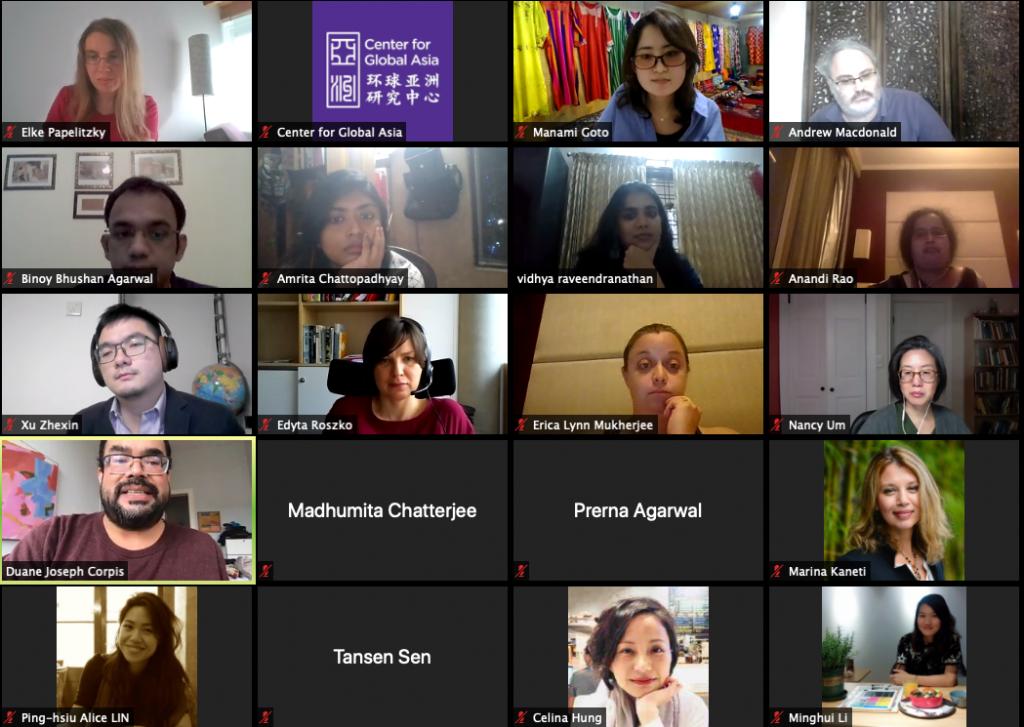联系我们
邮箱:shanghai.cga@nyu.edu
电话:+86 (21) 20595043
微信公众号:NYUShanghaiCGA
地址:
上海市浦东新区杨思西路567号
W822室

© 2024 All Rights Reserved

A Henry Luce-Funded Workshop
Vidhya Raveendranathan and Elke Papelitzky
Building on collective momentum from the previous “Indian Ocean Port Cities and Their Hinterlands Workshop” in September 2019, the second installment of the Workshop was held on Zoom on 23-24 October 2020, gathering 25 worldwide participants (including eight panel presenters) selected by Professor Duane Corpis, Professor Tansen Sen, and the Center’s doctoral and postdoctoral fellows from a total of seventy submissions in an open call. Eight scholars from Asia, South Africa and Europe presented their research on port cities in the Indian Ocean, ranging from Durban, South Africa, across the far southwest of the Indian Ocean, to cities such as Calcutta, Ayuthaya, Bombay, Bencoolen, Djibouti, Madras, Calcutta, Rangoon, Chittagong, and Aden, from the seventeenth century to today. Each panelist made a ten-minute presentation, followed by an extensive discussion of the pre-circulated papers. In contrast to our previous workshop, which focused on trade networks, labor migration, and governance structures within port cities, this second workshop touched upon diverse themes, such as gender relations, commodity circulation, gift-giving, and knowledge transfer.
After introductory comments from Tansen, the morning session began with a presentation by Manami Goto on the origins and diffusion of different types of face masks in the coastal areas of the Persian Gulf and the Western Indian Ocean, as well as the manner in which these were adapted and reshaped by the region’s maritime connections. This was followed by Prerna Agarwal, whose paper examined a particular strike episode in order to investigate the emergence of worker politics and the extent of connections established between workers of various occupations both within and outside the Calcutta docks. In her paper, Marina Kaneti challenged gendered representations across the Indian Ocean with their implicit focus on these ports being an exclusive domain of masculine patriarchy. Instead, her paper demonstrated the centrality of women in shaping maritime interactions in the pre-colonial world.
In the afternoon session, Andrew MacDonald discussed the ecological, political, and commercial transformations that developed Durban into a key gateway for trade and a site for the confinement of a mobile laboring population. In the final presentation of the day, Elke Papelitzky discussed how the Chinese, Dutch, and French sources mentioned the challenges sailors encountered while sailing in the Gulf of Thailand to the port city of Ayutthaya in the fifteenth and eighteenth centuries.
The second day started with Xu Zhexin’s paper on medieval maritime trade, the regional history of southeastern China, and the role of the often marginalized hinterlands. Following this, Madhumita Chatterjee’s presentation argued that medieval port cities like al-Fustat (Old Cairo), Aden, Nahrwara (Patan), Cambay, Ghogha, and al-Manjrur (Mangalore) did not function merely as conduits for commercial expansion but also as sites for community formation and the articulation of emotional ties among Arab Muslim and Jewish mercantile communities. Binoy Bhushan looked at port cities as messy contact zones for studying cross-cultural encounters and the transnational dynamics of race, class, and caste relations in colonial Calcutta. In the final paper of the afternoon session, Amrita Chattopadhyay pointed out the centrality of trade in perfumes in commodity circulation and economic exchange in the Indian ocean. Given that perfumes were central to court culture, religious practices, and the consumption practices of the elites, she demonstrated how port cities became the epicentre of the circulation of aromatic objects. To end the session, Duane Corpis and Celina Hung offered concluding remarks.
During the Workshop, Nancy Um delivered her keynote speech on “远近高低各不同:画中的摩卡港.” At the center of her discussion stood two images of the port city of Mocha from the seventeenth century, one made by Dutch, the other by Indian artists. Nancy argued that while at first glance we might believe the Dutch image to be more reliable, as it seems more “realistic,” Dutch artists took liberties in depicting buildings, as the respective Indian image provides different information. Each of the images had their own story to tell, and each of them helps us to understand space in Mocha in its own way.
The papers presented at the Workshop will be published in the two journals the Center co-edits: the Journal of Indian Ocean World Studies and Crossroads: An Interdisciplinary Journal of Asian Interactions.

邮箱:shanghai.cga@nyu.edu
电话:+86 (21) 20595043
微信公众号:NYUShanghaiCGA
地址:
上海市浦东新区杨思西路567号
W822室

© 2024 All Rights Reserved